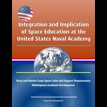Integration and Implication of Space Education at the United States Naval Academy: Navy and Marine Corps Space Cadre and Support Requirements, Midshipmen Academic Development
Integration and Implication of Space Education at the United States Naval Academy: Navy and Marine Corps Space Cadre and Support Requirements, Midshipmen Academic Development
€ 7,36
This mid-2018 report has been professionally converted for accurate flowing-text e-book format reproduction. Space competency is critical to winning our future wars. Over the past 60 years, the United States Navy (USN) has played an essential role as an active enabler of space-based capabilities. In this day and age, when adversaries continue to mature their own space capabilities to deny U.S. capabilities, further developing space-based systems for Naval and Marine Corps operations is imperative. While the USN's professional Naval Space Cadre has grown in numbers and improved its proficiency in recent years, the USN must invest in space support to the warfighter in order to increase space-based fleet training that will strengthen the cadre as well as the end users. This thesis identifies gaps in the space-based education that is being provided to the Midshipmen at the United States Naval Academy. This study finds that the United States Naval Academy needs to increase awareness of the Navy and Marine Corps' reliance on space-based systems, and to emphasize the growing need for space professionals, through education. Expanding curricula to Midshipmen on space-based systems and operations could be the key to enhancing the Navy Space Cadre for the future and protecting warfighters.
I. Introduction * A. Background * B. Purpose * C. Research Questions * D. Benefit Of Study * Ii. Analysis Of U.S. Navy And Marine Corps Space Cadre And Support Requirements * A. Policy * B. Space Reliance * C. Manpower Navy Space Cadre * D. Responsibilities * 1. Navy Space Cadre Responsibilities * 2. Marine Corps Space Cadre Responsibilities * E. Future Of The Navy Space Cadre * F. Future Marine Space Cadre * Iii. The United States Naval Academy Professional And Academic Development * A. Midshipmen Professional Development * B. Midshipmen Academic Development * C. Offered Space Education At The Usna * Iv. Space Education At The United States Air Force Academy, United States Military Academy And Naval Postgraduate School * A. U.S. Air Force Academy Astronautical * Engineering, Space Operations, Systems * Engineering (Space Systems) * B. West Point Space Science Major And Minor * C. Naval Postgraduate School * V. Analysis And Recommendations * A. U.S. Naval Academy Analysis * B. Integrating Space-Related Education At The Usna * C. Tier One: Integrated Space Education In The Midshipmen Training Program * D. Tier Two: Integration Of Space Education Into Existing Core Curricula * 1. Nn310: Advanced Navigation * 2. Es300: Naval Weapons Systems * 3. Ns42xx: Junior Officer Practicum * E. Tier Three: Integration Of A New Space Operations Major At The Usna * Vi. Conclusion And Future Work * A. Conclusions * B. Future Work * 1. Course Improvement And Course Development * 2. Integration Of Space Operations And Cyber Operations * 3. Classified Level Education
This mid-2018 report has been professionally converted for accurate flowing-text e-book format reproduction. Space competency is critical to winning our future wars. Over the past 60 years, the United States Navy (USN) has played an essential role as an active enabler of space-based capabilities. In this day and age, when adversaries continue to mature their own space capabilities to deny U.S. capabilities, further developing space-based systems for Naval and Marine Corps operations is imperative. While the USN's professional Naval Space Cadre has grown in numbers and improved its proficiency in recent years, the USN must invest in space support to the warfighter in order to increase space-based fleet training that will strengthen the cadre as well as the end users. This thesis identifies gaps in the space-based education that is being provided to the Midshipmen at the United States Naval Academy. This study finds that the United States Naval Academy needs to increase awareness of the Navy and Marine Corps' reliance on space-based systems, and to emphasize the growing need for space professionals, through education. Expanding curricula to Midshipmen on space-based systems and operations could be the key to enhancing the Navy Space Cadre for the future and protecting warfighters.
I. Introduction * A. Background * B. Purpose * C. Research Questions * D. Benefit Of Study * Ii. Analysis Of U.S. Navy And Marine Corps Space Cadre And Support Requirements * A. Policy * B. Space Reliance * C. Manpower Navy Space Cadre * D. Responsibilities * 1. Navy Space Cadre Responsibilities * 2. Marine Corps Space Cadre Responsibilities * E. Future Of The Navy Space Cadre * F. Future Marine Space Cadre * Iii. The United States Naval Academy Professional And Academic Development * A. Midshipmen Professional Development * B. Midshipmen Academic Development * C. Offered Space Education At The Usna * Iv. Space Education At The United States Air Force Academy, United States Military Academy And Naval Postgraduate School * A. U.S. Air Force Academy Astronautical * Engineering, Space Operations, Systems * Engineering (Space Systems) * B. West Point Space Science Major And Minor * C. Naval Postgraduate School * V. Analysis And Recommendations * A. U.S. Naval Academy Analysis * B. Integrating Space-Related Education At The Usna * C. Tier One: Integrated Space Education In The Midshipmen Training Program * D. Tier Two: Integration Of Space Education Into Existing Core Curricula * 1. Nn310: Advanced Navigation * 2. Es300: Naval Weapons Systems * 3. Ns42xx: Junior Officer Practicum * E. Tier Three: Integration Of A New Space Operations Major At The Usna * Vi. Conclusion And Future Work * A. Conclusions * B. Future Work * 1. Course Improvement And Course Development * 2. Integration Of Space Operations And Cyber Operations * 3. Classified Level Education
| Prijs | Verzendkosten | Totaal | |
|---|---|---|---|
€ 7,36 | € 0,00 | € 7,36 |
Alternatieve producten
© 2016 - 2024 aanbiedingchecker

